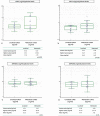Baseline plasma levels of soluble PD-1, PD-L1, and BTN3A1 predict response to nivolumab treatment in patients with metastatic renal cell carcinoma: a step toward a biomarker for therapeutic decisions
- PMID: 33178494
- PMCID: PMC7595592
- DOI: 10.1080/2162402X.2020.1832348
Baseline plasma levels of soluble PD-1, PD-L1, and BTN3A1 predict response to nivolumab treatment in patients with metastatic renal cell carcinoma: a step toward a biomarker for therapeutic decisions
Abstract
Despite a proportion of renal cancer patients can experiment marked and durable responses to immune-checkpoint inhibitors, the treatment efficacy is widely variable and identifying the patient who will benefit from immunotherapy remains an issue. We performed a prospective study to investigate if soluble forms of the immune-checkpoints PD-1 (sPD-1), PD-L1 (sPD-L1), pan-BTN3As, BTN3A1, and BTN2A1, could be candidate to predict the response to immune-checkpoint blockade therapy. We evaluated the plasma levels in a learning cohort of metastatic clear cell renal carcinoma (mccRCC) patients treated with the anti-PD-1 agent nivolumab by ad hoc developed ELISA's. Using specific cut-offs determined through ROC curves, we showed that high baseline levels of sPD-1 (>2.11 ng/ml), sPD-L1 (>0.66 ng/ml), and sBTN3A1 (>6.84 ng/ml) were associated with a longer progression-free survival (PFS) to nivolumab treatment [median PFS, levels above thresholds: sPD-1, 20.7 months (p < .0001); sPD-L1, 19 months (p < .0001); sBTN3A1, 17.5 months (p = .002)]. High sPD-1 and sBTN3A1 levels were also associated with best overall response by RECIST and objective response of >20%. The results were confirmed in a validation cohort of 20 mccRCC patients. The analysis of plasma dynamic changes after nivolumab showed a statistically significant decrease of sPD-1 after 2 cycles (Day 28) in the long-responder patients. Our study revealed that the plasma levels of sPD-1, sPD-L1, and sBTN3A1 can predict response to nivolumab, discriminating responders from non-responders already at therapy baseline, with the advantages of non-invasive sample collection and real-time monitoring that allow to evaluate the dynamic changes during cancer evolution and treatment.
Keywords: BTN2A1; BTN3A1; PD-1; PD-L1; butyrophilins; circulating immune checkpoints; immunotherapy response; predictive biomarker; renal cell carcinoma; soluble immune-checkpoints.
© 2020 The Author(s). Published with license by Taylor & Francis Group, LLC.
Figures





Similar articles
-
Low plasma PD-L1 levels, early tumor onset and absence of peritoneal carcinomatosis improve prognosis of women with advanced high-grade serous ovarian cancer.BMC Cancer. 2023 May 13;23(1):437. doi: 10.1186/s12885-023-10911-5. BMC Cancer. 2023. PMID: 37179293 Free PMC article.
-
Prognostic role of soluble PD-1 and BTN2A1 in overweight melanoma patients treated with nivolumab or pembrolizumab: finding the missing links in the symbiotic immune-metabolic interplay.Ther Adv Med Oncol. 2023 Feb 15;15:17588359231151845. doi: 10.1177/17588359231151845. eCollection 2023. Ther Adv Med Oncol. 2023. PMID: 36818688 Free PMC article.
-
Prognostic Role of Plasma PD-1, PD-L1, pan-BTN3As and BTN3A1 in Patients Affected by Metastatic Gastrointestinal Stromal Tumors: Can Immune Checkpoints Act as a Sentinel for Short-Term Survival?Cancers (Basel). 2021 Apr 27;13(9):2118. doi: 10.3390/cancers13092118. Cancers (Basel). 2021. PMID: 33925671 Free PMC article.
-
Soluble PD-L1 changes in advanced non-small cell lung cancer patients treated with PD-1 inhibitors: an individual patient data meta-analysis.Front Immunol. 2023 Nov 23;14:1308381. doi: 10.3389/fimmu.2023.1308381. eCollection 2023. Front Immunol. 2023. PMID: 38115995 Free PMC article.
-
Systemic Analysis and Review of Nivolumab-ipilimumab Combination as a Rescue Strategy for Renal Cell Carcinoma After Treatment With Anti-PD-1/PD-L1 Therapy.Clin Genitourin Cancer. 2021 Apr;19(2):95-102. doi: 10.1016/j.clgc.2020.10.004. Epub 2020 Oct 15. Clin Genitourin Cancer. 2021. PMID: 33189597 Review.
Cited by
-
A Review of Recent Research on the Role of MicroRNAs in Renal Cancer.Med Sci Monit. 2021 May 8;27:e930639. doi: 10.12659/MSM.930639. Med Sci Monit. 2021. PMID: 33963171 Free PMC article. Review.
-
Co-Inhibitory Molecules - Their Role in Health and Autoimmunity; Highlighted by Immune Related Adverse Events.Front Immunol. 2022 Jun 16;13:883733. doi: 10.3389/fimmu.2022.883733. eCollection 2022. Front Immunol. 2022. PMID: 35784333 Free PMC article. Review.
-
Butyrophilins: Dynamic Regulators of Protective T Cell Immunity in Cancer.Int J Mol Sci. 2023 May 13;24(10):8722. doi: 10.3390/ijms24108722. Int J Mol Sci. 2023. PMID: 37240071 Free PMC article. Review.
-
Pre-treatment soluble PD-L1 as a predictor of overall survival for immune checkpoint inhibitor therapy: a systematic review and meta-analysis.Cancer Immunol Immunother. 2023 May;72(5):1061-1073. doi: 10.1007/s00262-022-03328-9. Epub 2022 Nov 16. Cancer Immunol Immunother. 2023. PMID: 36385210 Free PMC article.
-
Soluble PD-L1 as a Prognostic Factor for Immunotherapy Treatment in Solid Tumors: Systematic Review and Meta-Analysis.Int J Mol Sci. 2022 Nov 21;23(22):14496. doi: 10.3390/ijms232214496. Int J Mol Sci. 2022. PMID: 36430974 Free PMC article.
References
-
- Incorvaia L, Bronte G, Bazan V, Badalamenti G, Rizzo S, Pantuso G, Natoli C, Russo A. Beyond evidence-based data: scientific rationale and tumor behavior to drive sequential and personalized therapeutic strategies for the treatment of metastatic renal cell carcinoma. Oncotarget. 2016;7(16):21259–21271. doi:10.18632/oncotarget.7267. - DOI - PMC - PubMed
MeSH terms
Substances
LinkOut - more resources
Full Text Sources
Medical
Research Materials
